Shop Curriculum Resources and Activities
All products are purchased from my TpT Store!
Biology
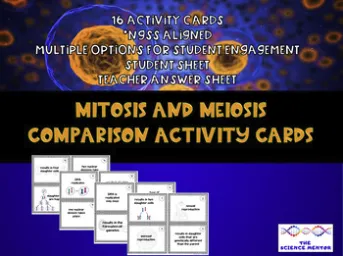
Mitosis and Meiosis Comparison Activity Cards
These activity cards offer students a hands-on approach to grasp complex concepts by organizing and categorizing abstract ideas. Whether working together or individually, students engage with 16 illustrated cards to compare and contrast mitosis and meiosis, enhancing their understanding through tangible manipulation.
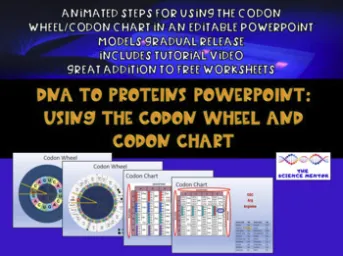
From DNA to Proteins: Using the Codon Wheel and Chart PowerPoint
This PowerPoint presentation serves as a supplementary tool for students, providing guidance on using the Codon Wheel or Chart for assignments outside of class. Linked with a tutorial video on YouTube, it offers detailed explanations and interactive animations to aid comprehension and self-paced learning.
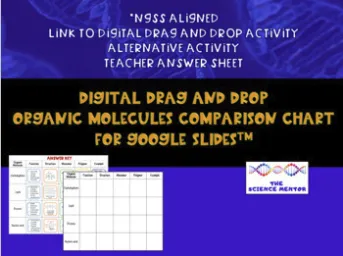
Digital Drag and Drop Organic Molecule Comparison Activity
Students engage in matching the function, structure, monomers, polymers, and examples of organic molecules by dragging and dropping color-coded squares or completing a hands-on version by cutting and categorizing pieces into a graphic organizer. This versatile activity provides educators with multiple options for integrating it into their lessons, serving as an opening activity, review session, quiz, or reinforcement tool, with both digital and printable versions available.
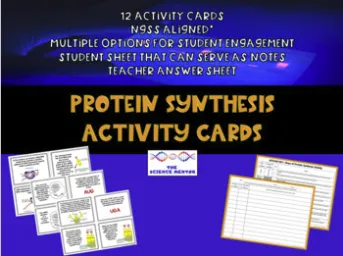
Protein Synthesis Activity Cards
Students engage in this activity in recommended group sizes of 2 to 3 individuals for optimal engagement. Before sorting the cards to sequence protein synthesis steps, I work with students to review cellular locations, encouraging active participation and discussions to clarify understanding before debriefing as a class.
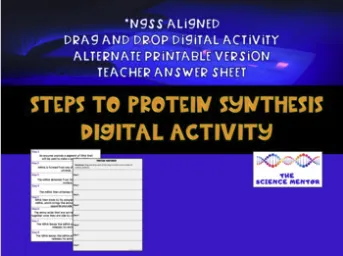
Steps to Protein Synthesis Digital Activity
In this collaborative activity, students partner up to sequence strips representing steps of protein synthesis, actively engaging with the process without prior introduction to the term. After their initial attempt, we go over the steps with other activities or videos, pausing to review and refine their sequence. By saving their organized steps as notes, students develop a deeper understanding, as they are more likely to revisit and engage with their own work, enhancing their learning beyond mere copying from presentations.
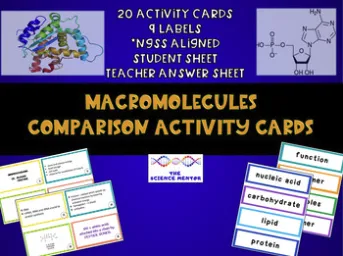
Macromolecule Comparison Activity Cards
This versatile interactive activity serves as an effective tool for opening discussions, reviewing concepts, or reinforcing learning regarding macromolecules. Students engage in hands-on learning by creating graphic organizers on their desks, categorizing 20 activity cards based on characteristics such as function, monomer, polymer, and structure, fostering collaborative learning and reinforcing vocabulary acquisition.
Chemistry
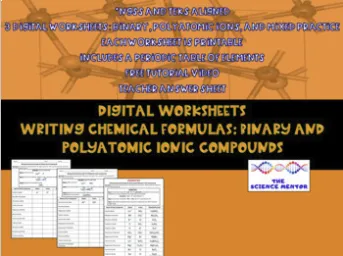
Writing Chemical Formulas: Binary & Polyatomic Ionic Compounds (Digital + Print)
These digital worksheets offer a comprehensive guide to mastering the crisscross method for writing chemical formulas of ionic compounds. From binary compounds to polyatomic and mixed compounds, students receive step-by-step instructions alongside practice problems and helpful examples.
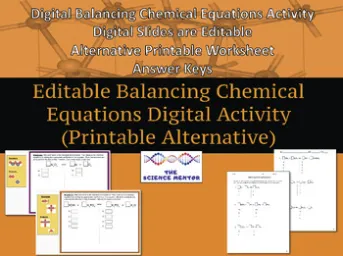
Balancing Chemical Equations (Digital Activity + Printable Worksheets)
This Google Slides digital activity offers educators a versatile tool to aid students in visualizing and balancing chemical equations effectively, whether for introduction, reinforcement, or review. With editable slides and detailed instructions on utilizing the Master Slides, teachers can easily adapt the activity to suit their teaching preferences.

Forming Ionic Compounds Digital Activity
This activity offers a hands-on approach to understanding how ions form chemical bonds by allowing students to match cations and anions to create neutral ionic compounds, aided by color-coded ion pieces. Designed for both physical and online settings, students can work individually or in pairs, facilitating discussions and personalized reviews to assess comprehension effectively.
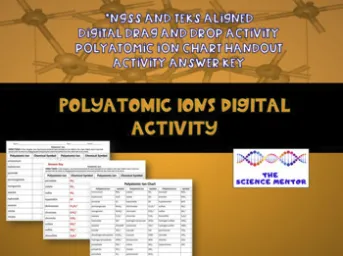
Polyatomic Ions Digital Activity
This digital activity provides students with an interactive way to familiarize themselves with 40 polyatomic ions by matching their chemical ionic formulas to their names through drag-and-drop exercises across two Google® slides. Alongside the activity, an answer key and a printable Polyatomic Ions Chart handout are included to aid comprehension and serve as a reference tool for students.

Ionic Bonds Digital Activities and Worksheets Bundle (Digital + PDF Worksheets)
This bundle includes three of my most popular digital activities and worksheets. All three products are Google-™ Slides activities. The Forming Ionic Bonds and Writing Chemical Formulas: Binary and Polyatomic Compounds Worksheets have is PDF version for easier printing.
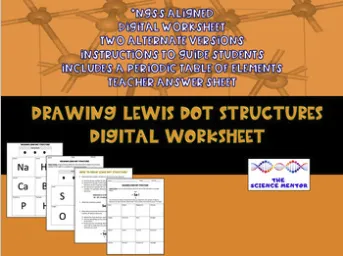
Drawing Lewis Dot Structures - Digital Activity + Printable Alternatives
This interactive digital activity enables students to construct Lewis Dot Structures by dragging and dropping electrons from an Electron Bank, utilizing the provided Periodic Table of Elements to determine valence electron numbers. With alternative PDF versions available and teacher answer keys provided, educators can seamlessly integrate this resource into their curriculum, catering to diverse learning preferences while ensuring accurate assessment.
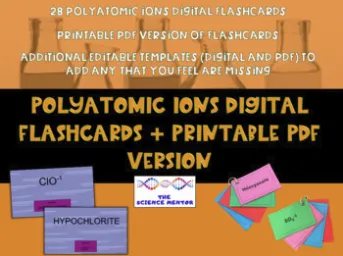
Polyatomic Ions Digital Flashcards + Printable PDF Version
This product offers two versions of flashcards featuring 29 polyatomic ions, providing flexibility for both digital and printable review methods. The digital version, accessible through Google Slides®, allows customization by duplicating slides to add ions or removing unnecessary ones, while a separate printable PDF version provides an offline option for students who prefer tangible materials.
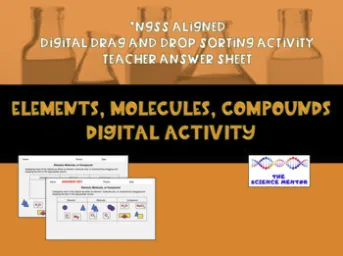
Elements, Molecules, or Compounds Digital Activity
This digital activity provides versatile options for engaging students in categorizing elements, molecules, and compounds, whether as a pre-assessment, collaborative group task, or review exercise. With a video demonstration included, educators can seamlessly integrate the activity into lessons and assess student understanding based on completion time and organization.
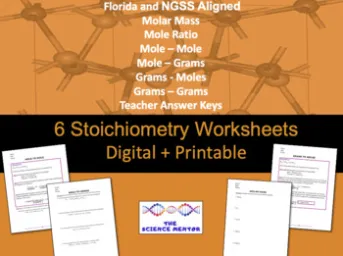
6 Stoichiometry Practice Worksheets - Digital and Printable
This comprehensive product offers six different practice worksheets covering various aspects of mole calculations, each featuring step-by-step examples ideal for guided practice, homework assignments, or review sessions. Included are practice worksheets for mole ratio, molar mass, mole-mole, mole-grams, grams-grams, and grams-grams conversions, along with answer keys for easy assessment. With both digital and printable versions available, educators can seamlessly integrate these resources into their lessons while catering to different learning preferences.
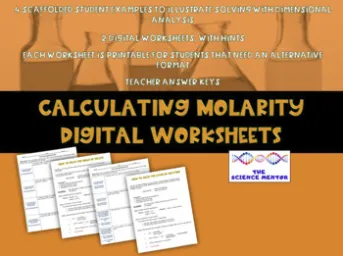
Calculating Molarity Digital Worksheets
This product offers a comprehensive approach to tackling molarity problems by providing detailed examples and scaffolding for solving common types of problems. With both digital and printable versions available, along with teacher answer keys and a Periodic Table of Elements, this resource accommodates various learning preferences and is suitable for both classroom and distance learning environments.
FREE Resources
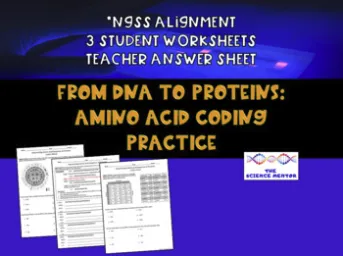
From DNA to Proteins: Amino Acid Coding Practice
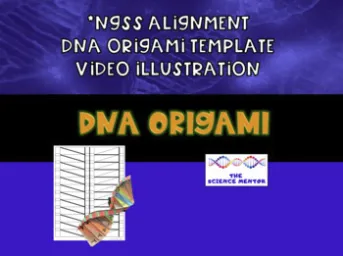
DNA Origami
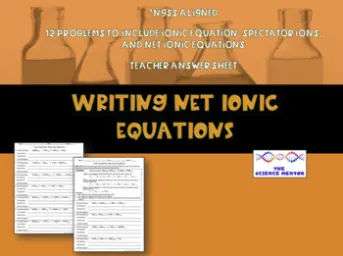
Writing Net Ionic Equations
YouTube Tutorials
Click "Watch More" to Explore more videos Tutorials on topics in science
All Rights Reserved 2023 - (C) TheScienceMentor.com -TM | Terms & Conditions | Privacy Policy | Disclaimers
